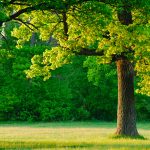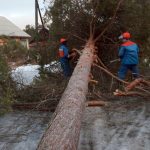Common Tree Hazards
Winters in western Oregon and Washington are always wet. Storms blow through, shattering limbs and uprooting trees from the water-soaked earth. If there’s snow and ice, trees have to deal with that much more weight. More weight means more opportunities for broken branches–and more tree hazards.
Even in the best of conditions, trees in failing health can still be quite hazardous. Spring pests and diseases can weaken a tree from the inside. If you don’t know the warning signs, you could be dodging dead branches that could fall at any time.
Inspect Your Tree for Tree Hazards
It’s a good idea to inspect your trees before and after a big storm and from time to time through the year. Don’t check them during windy weather. If you think one of your large trees may be damaged, don’t stand under it. Use binoculars to get a better look without having to get too near.
Damaged trees pose a threat to people and property. The bigger the tree, the more hazardous it is. A Douglas Fir, for example, can grow several feet in diameter and many times taller than a home. Imagine if a tree that large were to fall on your house. But, there’s nothing like knowledge and action to calm your nerves. If you’re worried about your trees, give them a close look.
Common Tree Hazards
 Winter is an ideal time to get a good view: When branches are bare, it’s easier to see problems. Here’s what to check for when it comes to tree hazards
Winter is an ideal time to get a good view: When branches are bare, it’s easier to see problems. Here’s what to check for when it comes to tree hazards
- Dead, Broken, or Weak Branches
- Cavities in the Trunk or Branches
- Multiple Trunks
- Rot and Fungus
- Cracks in the Trunk or Branches
- Trees Growing in a Construction Zone
Dead, Broken, or Weak Branches
A broken limb can fall and injure someone or damage your property. Sometimes branches can be cracked but still firmly attached, posing no immediate threat of falling. When a partially attached branch pulls away, it can peel away the bark near the break. If a limb loses more than a third of its circumference of bark, you or a certified arborist should remove it.
Cavities in the Trunk or Branches
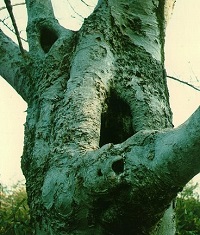 A neglected bark injury can turn into a cavity or hollow. Any stress, such as fires, storms, fungus, or improper pruning can turn into a cavity. These stressors expose a tree’s heartwood. Without bark to protect it, the heartwood is vulnerable to fungal infections which can lead to decay and tree failure.
A neglected bark injury can turn into a cavity or hollow. Any stress, such as fires, storms, fungus, or improper pruning can turn into a cavity. These stressors expose a tree’s heartwood. Without bark to protect it, the heartwood is vulnerable to fungal infections which can lead to decay and tree failure.
Squirrels, birds, raccoons, and other animals love to make decaying trees their homes and a hollow makes a great front door. Carpenter ants will also attack a decaying tree via the cavity. These insects dig paths throughout the tree trunk and the tunnels collect water and promote rot. When the rot and decay consume enough of the tree, it becomes weakened and can fall in high winds.
Rot and Fungus
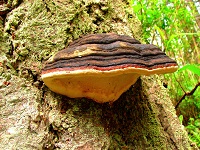 Conifers, especially Douglas firs (Oregon’s state tree), are common throughout Portland and the rest of the Pacific Northwest. These tree species are prone to fungus and root diseases, also called root and butt rots, that can spread for decades if left to persist. They eventually cause a tree to fall.
Conifers, especially Douglas firs (Oregon’s state tree), are common throughout Portland and the rest of the Pacific Northwest. These tree species are prone to fungus and root diseases, also called root and butt rots, that can spread for decades if left to persist. They eventually cause a tree to fall.
Five of the most havoc-wreaking root diseases are laminated root rot (the most dangerous in regards to dead trees), Armillaria root disease, annosus root disease, black-stain root disease, and tomentosus root rot. Some of the symptoms of such infections include:
- Mushrooms or ‘conks’ that grow on the roots or on root collar
- Basal resin (sap) flow and stained bark
- Presence of bark beetles
- Fading foliage, dying branches, premature shedding of older needles, and irregular shoot growth throughout the tree’s crown
- Cone crops showing signs of distress
Multiple Trunks May Lead to Tree Hazards
Because a tree has multiple trunks, it doesn’t necessarily mean it’s a hazard. Trees with split or multiple trunks are weaker at the split than single-trunk trees. It’s often the trees with more than one trunk that get split down the middle in a windstorm. After a storm, look for cracks or breaks where the trunks come together.
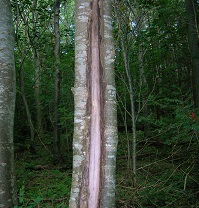 Cracks in the Trunk or Branches
Cracks in the Trunk or Branches
Cracks can form from frost, frequent high winds (especially when preceded by rot), lightning strikes, and substantial decay. This kind of structural defect in the trunk, or main stem of the tree, can cause the tree or parts of it to fail. Sometimes cracks caused by frost can heal, but in general a crack is a sign of decay.
The larger the crack the more likely it is that the tree will die. Trunks that are completely split down the middle are very dangerous and difficult to brace adequately. Trees with such a severe defect should be addressed and/or removed by professional tree service companies or arborists.
Trees Growing in a Construction Zone
Construction can cause stress to trees and their roots, especially shallow feeder roots. Disruptions to the soil when putting in a new driveway, plumbing, or utility lines may affect trees and cause root damage. Heavy equipment can scrape tree bark which may lead to disease or bug infestation.
Vehicles and foot traffic compact the soil, depriving roots of oxygen. If the root system is damaged, it may starve or destabilize the tree. Try to protect your trees from construction by installing a temporary fence. Keep a close eye on your trees during and after construction.
Emergency Tree Service
If storms wreck your trees, give us a call for pruning and dangerous tree removal in Portland. Inexpensive Tree Care will remove dangling and split branches, safely take down a dangerous tree and grind away stumps. We can also address fallen trees
Winter storms in Portland are inevitable, but a dangerous falling tree situation isn’t. If you have a tree with one or more of these types of hazards, contact Inexpensive Tree Care right away. We will be glad to inspect your tree and help with your tree removal situation. Before emergency tree removal services are needed, we’ll do our best to save the tree.


